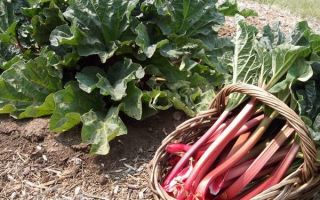Content
- 1 Chemical composition and calorie content of rhubarb
- 2 The benefits of rhubarb for the body
- 3 Is rhubarb possible for pregnant women
- 4 Rhubarb while breastfeeding
- 5 Can rhubarb be given to children
- 6 Rhubarb recipes in traditional medicine
- 7 The use of rhubarb in cosmetology
- 8 What can you make with rhubarb
- 9 When to harvest and store rhubarb
- 10 Contraindications and possible harm to rhubarb
- 11 Conclusion
The benefits of rhubarb leaves, or rather, not the leaves themselves, but their petioles, are undeniable. This plant is used not only in cooking, but also as a medicine. In nature, there are several varieties of it, each of which is used by people for different purposes. When using a vegetable, you need to understand what type of plant we are talking about - about medicinal, intended for use as food, or about decorative.
When using it, it is necessary to remember the expression "medicine in a drop, poison in a cup", since the benefits and harms of rhubarb are inseparable, and what effect the plant will give depends, among other things, on its dosage.
In medicine, the rhizomes of finger and medicinal rhubarb, as well as some types of food, are used. The petioles of the leaves are used for food, and the leaves themselves are sometimes used as a seasoning.
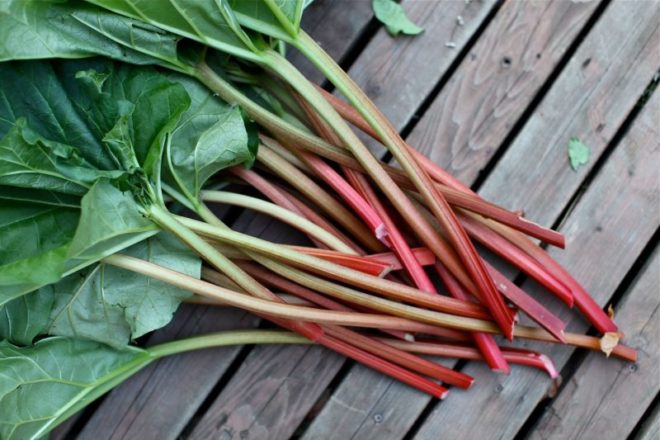
Chemical composition and calorie content of rhubarb
Rhubarb is a low-calorie food - its calorie content is only 16 kcal per 100 grams. The ratio of proteins, fats and carbohydrates in it is approximately as follows: proteins - 0.7 g; fats - 0.1 g; carbohydrates - 2.5 g. Due to the low calorie content, it is recommended to drink rhubarb compotes for diabetes.
The chemical composition of the product is varied. The vegetable contains a large amount of vitamins (vitamins A, B, C, E and K), which is why it was used as a prophylactic treatment for scurvy.
The plant roots contain the following groups of substances:
- anthracene derivatives (can be used as laxatives);
- tanning (can be used as anti-inflammatory and hemostatic agents, however, in some cases, poisoning is possible);
- pectin;
- bitter glycosides (help to improve digestion);
- flavonoids.

The benefits of rhubarb for the body
Rhubarb is used as a medicine not only in official but also in traditional medicine. So, a large amount of vitamin in rhubarb makes it possible to use the vegetable as a prophylaxis of vitamin deficiency, anemia and even scurvy.
Benefits for women
Several medicinal properties of rhubarb will be especially beneficial for the female body. First, a significant concentration of vitamin E improves the overall health of the body. In particular, the skin and nails, and also improves the condition of the hair and reduces hair loss. Secondly, the infusion from its roots can be used as an antispasmodic agent, which is especially valuable during the menstrual period. Thirdly, the consumption of this vegetable in food has a positive effect on the preservation of vision (this, of course, applies not only to women).

Benefits for men
For men, the use of this plant can be beneficial in several cases:
- Prevention of cardiovascular diseases - this is facilitated by an improvement in blood circulation, a decrease in cholesterol levels, and vasodilation.
- In the case of regular use of tobacco products and (or) alcohol, rhubarb reduces the negative impact on the body, removes toxins, and weakens the hangover syndrome.
- The plant can be used to improve memory.
Slimming
Since the calorie content of the vegetable is low, it can be safely used in the process of losing weight. It can be eaten both raw and as part of other dishes. At the same time, dishes containing rhubarb in the composition can be baked or stewed, but not fried.
If, while dieting, the digestion process deteriorates, you must stop eating the vegetable and return to your usual diet. There is no diet focused on this particular plant (like chocolate or cabbage), as consuming large amounts of it will lead to food poisoning.
Rhubarb is used in the course of weight loss just like any other vegetable.
Is rhubarb possible for pregnant women
Rhubarb has many beneficial properties, many of which are also relevant during pregnancy.
Immediately, we note that it is necessary to consume a vegetable in small quantities, since too large doses can have negative consequences. During this period, rhubarb leaves should not be eaten, only petioles.
How a vegetable can be useful during pregnancy:
- A large amount of vitamins contained in rhubarb helps a woman's body to endure this period easier - calcium strengthens teeth, hair and bones, vitamin A helps to maintain vision, vitamin C increases immunity.
- The low calorie content of the vegetable will prevent you from gaining excess weight.
- It helps against constipation, so you can avoid using pills.
- The diuretic effect of rhubarb helps to reduce swelling.
Rhubarb while breastfeeding
During breastfeeding, this vegetable should be eaten with extreme caution, since the acidity can be dangerous for the baby. In general, the lactation period refers to the contraindications for the use of this vegetable for food. In no case should the plant be eaten raw. It can be used carefully and in moderation only after heat treatment, as a compote or jam.
If possible, during breastfeeding it is better to do without this plant on the menu.
Can rhubarb be given to children
Since rhubarb contains some types of acids (for example, oxalic), it can be dangerous to eat it in some cases. Therefore, in the first years of a child's life, it is better not to feed him this vegetable.
At what age children can rhubarb
After the child reaches the age of one and a half years, you can - with the permission of the pediatrician - use the plant as a medicine.
As a food product, it can be consumed starting from about two to three years (earlier - only with the permission of a doctor and for medicinal purposes). The vegetable must necessarily undergo heat treatment: you can carefully give the child rhubarb jam or compote.
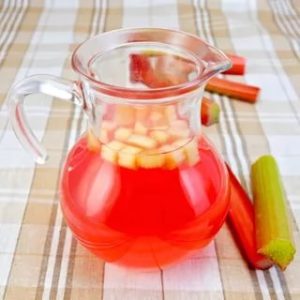
How to cook rhubarb for your baby
The first time it is recommended to make a compote. Rhubarb compote for children is made as follows: peel the stems, squeeze the juice out of them. Then boiled hot water mixed with fruit juice is added to the juice to improve the taste of the drink. Introduce into the diet, gradually increasing the dose, while the first time you need to give very little.
When the child grows up, you can give him regular meals containing this vegetable.
Rhubarb recipes in traditional medicine
In folk medicine, this plant is used in different ways, sometimes very unexpected:
- Rhubarb root tincture is used to normalize bowel function.
- Diluted root powder is used to stop diarrhea.
- A decoction of the petioles will reduce the pressure.
- The benefits of rhubarb juice are revealed in the prevention of vitamin deficiency. The juice is squeezed out of the stalks of the plant and drunk every day.
- Infusion of rhubarb, dandelion and celandine is used to treat anemia.
- The rhubarb compress is used as an antiseptic and as a treatment for fractures.
- Finally, its use in any form is an excellent prevention of cardiovascular diseases.
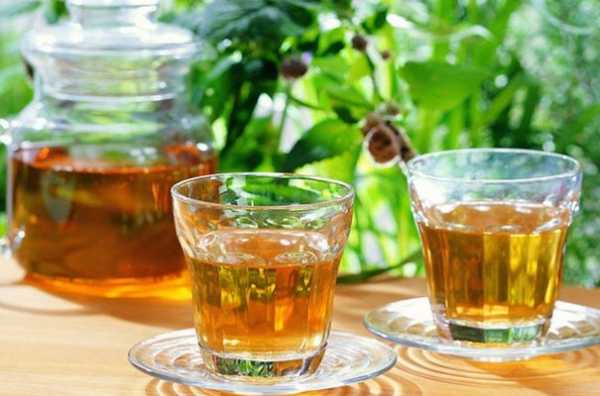
The use of rhubarb in cosmetology
For cosmetic purposes, the plant can be used as:
- anti-acne remedy;
- means for whitening the skin and removing age spots;
- hair coloring agent.
For acne (and bruising), a compress made from grated root mixed with vinegar is used.
Rhubarb for face cleansing is used in the form of masks: juice from the stalks, mixed with ground oatmeal and cream (in a proportion of 2 tablespoons of juice to 1 spoonful of flakes and one cream). The resulting mask is applied on the face or on the necessary areas of the body and left for about 15-20 minutes.
When dyeing hair (the method is suitable only for light hair), a decoction is used: 30 grams of chopped roots are diluted with a glass of cold water, brought to a boil and cooked for 15 minutes over low heat, stirring constantly. The resulting broth after cooling is rubbed into clean, dry hair. It does not need to be washed off.
What can you make with rhubarb
There are many recipes that allow the use of this plant both as a seasoning and as an independent vegetable. Let's take a look at how to use rhubarb in cooking.
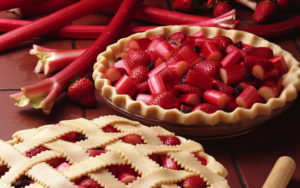
Without touching the recipes for medicines based on this vegetable, it can be used to prepare:
- compotes, juices and fruit drinks;
- salads;
- jam;
- toppings for pies;
- soups;
- sauces;
- candied fruits;
- the leaves of the plant are used as a condiment in the preparation of fish.
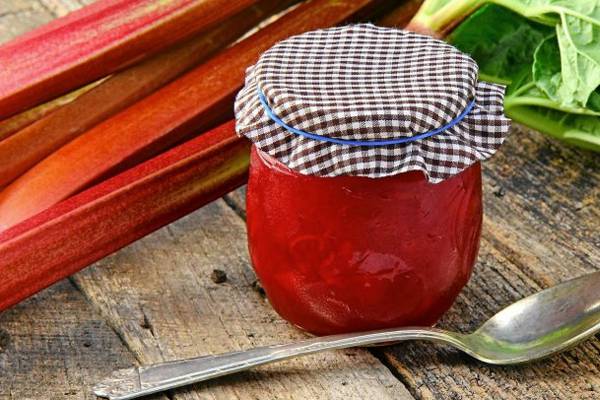
When to harvest and store rhubarb
Since it is a perennial plant, harvesting takes place in two stages. At the first stage, the leaves are collected, and during the second (possibly in a few years), the roots are dug out.
The roots can be dug up after the plant is four years old. After that, they are washed, cut into small pieces and dried first in the open air, then in dryers at a temperature of 60 degrees. The stalks are plucked gradually, three to four times per season. It is customary to finish harvesting at the end of July so that the plant can gain strength by next year.
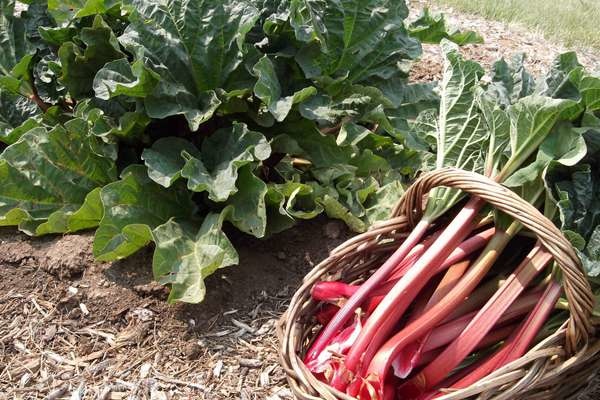
There are several ways to harvest rhubarb for the winter:
- as homemade preparations - jam or compotes;
- by freezing;
- leaving the dried roots in a cool, dark, ventilated place.
You can freeze a vegetable with or without a skin. For compotes, the option with the skin is also suitable, and if you plan to use the plant as a filling for pies or for salad, it is better to remove the skin. You can freeze both as part of a salad mixture and a separately washed plant.
Can be frozen in sugar: the peeled and washed vegetable is cut into pieces and placed in a food container in layers separated by sugar. A kilogram of petioles will require about one and a half to two glasses of sugar.
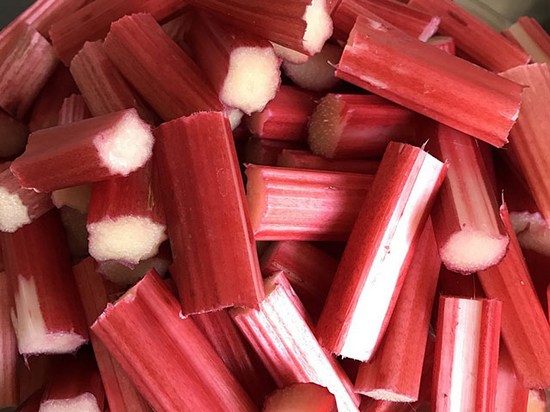
Contraindications and possible harm to rhubarb
Despite the tremendous health benefits of this plant, it can also be dangerous to consume. There are a number of contraindications in which the use of this vegetable is unacceptable:
- diseases of the gastrointestinal tract;
- internal bleeding;
- increased acidity of the stomach;
- allergic reaction;
- rheumatism;
- cholecystitis;
- inflammation of the bladder.
Eating a vegetable improperly can also lead to poisoning: the leaves of the plant, which are used as a seasoning, contain oxalic acid, which can be poisoned.
If you regularly eat large amounts of vegetables, acidity can increase, which can lead to joint and kidney disease.
Conclusion
The benefits and harms of rhubarb depend, first of all, on how correctly to use it.The usefulness of this plant is difficult to overestimate, but it is important to observe moderation in its use, as well as to remember about possible contraindications and the rules of use.

